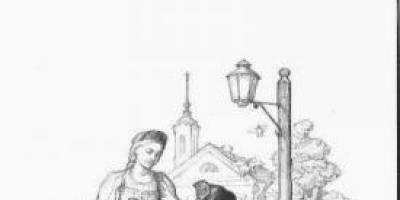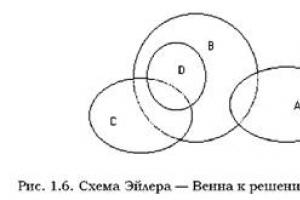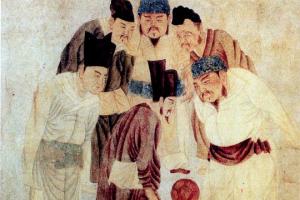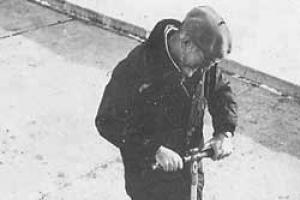It would seem that there is nothing simpler than Archimedes' law. But once upon a time Archimedes himself really puzzled over his discovery. How it was?
There is an interesting story connected with the discovery of the fundamental law of hydrostatics.
Interesting facts and legends from the life and death of Archimedes
In addition to such a gigantic breakthrough as the discovery of Archimedes’ law itself, the scientist has a whole list of merits and achievements. In general, he was a genius who worked in the fields of mechanics, astronomy, and mathematics. He wrote such works as a treatise “on floating bodies”, “on the ball and cylinder”, “on spirals”, “on conoids and spheroids” and even “on grains of sand”. The latest work attempted to measure the number of grains of sand needed to fill the Universe.

Role of Archimedes in the Siege of Syracuse
In 212 BC, Syracuse was besieged by the Romans. 75-year-old Archimedes designed powerful catapults and light short-range throwing machines, as well as the so-called “Archimedes claws”. With their help it was possible to literally turn over enemy ships. Faced with such powerful and technological resistance, the Romans were unable to take the city by storm and were forced to begin a siege. According to another legend, Archimedes, using mirrors, managed to set fire to the Roman fleet, focusing the sun's rays on the ships. The veracity of this legend seems doubtful, because None of the historians of that time mentioned this.
Death of Archimedes
According to many testimonies, Archimedes was killed by the Romans when they finally took Syracuse. Here is one of the possible versions of the death of the great engineer.
On the porch of his house, the scientist was thinking about the diagrams that he drew with his hand right in the sand. A passing soldier stepped on the drawing, and Archimedes, deep in thought, shouted: “Get away from my drawings.” In response to this, a soldier hurrying somewhere simply pierced the old man with a sword.
Well, now about the sore point: about the law and power of Archimedes...
How Archimedes' law was discovered and the origin of the famous "Eureka!"
Antiquity. Third century BC. Sicily, where there is still no mafia, but there are ancient Greeks.
An inventor, engineer and theoretical scientist from Syracuse (a Greek colony in Sicily), Archimedes served under King Hiero II. One day, jewelers made a golden crown for the king. The king, being a suspicious person, summoned the scientist to his place and instructed him to find out whether the crown contained silver impurities. Here it must be said that at that distant time no one had resolved such issues and the case was unprecedented.

Archimedes thought for a long time, came up with nothing, and one day decided to go to the bathhouse. There, sitting down in a basin of water, the scientist found a solution to the problem. Archimedes drew attention to a completely obvious thing: a body, immersed in water, displaces a volume of water equal to the body’s own volume.
It was then that, without even bothering to get dressed, Archimedes jumped out of the bathhouse and shouted his famous “Eureka,” which means “found.” Appearing to the king, Archimedes asked to give him ingots of silver and gold, equal in weight to the crown. By measuring and comparing the volume of water displaced by the crown and the ingots, Archimedes discovered that the crown was not made of pure gold, but was mixed with silver. This is the story of the discovery of Archimedes' law.
The essence of Archimedes' law
If you are asking yourself how to understand Archimedes' principle, we will answer. Just sit down, think, and understanding will come. Actually, this law says:
A body immersed in a gas or liquid is subject to a buoyancy force equal to the weight of the liquid (gas) in the volume of the immersed part of the body. This force is called the Archimedes force.

As we can see, the Archimedes force acts not only on bodies immersed in water, but also on bodies in the atmosphere. The force that makes a balloon rise up is the same Archimedes force. The Archimedean force is calculated using the formula:

Here the first term is the density of the liquid (gas), the second is the acceleration of gravity, the third is the volume of the body. If the force of gravity is equal to the force of Archimedes, the body floats, if it is greater, it sinks, and if it is less, it floats until it begins to float.

In this article we looked at Archimedes' law for dummies. If you want to learn how to solve problems where Archimedes' law is found, contact to our specialists. The best authors will be happy to share their knowledge and break down the solution to the most difficult problem “on the shelves.”
Archimedes is an outstanding ancient Greek mathematician, inventor and engineer who lived in the 3rd century BC. e. This man was born in 287 BC. e. in the city of Syracuse in Sicily. At that time it was a colony of Ancient Greece and was called Magna Graecia. It included the territory of modern Southern Italy and Sicily.
The date of birth is known from the words of the Byzantine historian John Tzetz. He lived in Constantinople in the 12th century. That is, almost one and a half thousand years after Archimedes. He also wrote that the famous ancient Greek mathematician lived 75 years. Such accurate information raises certain doubts, but let us show respect for the outstanding minds of antiquity and accept the indicated dates and figures as the truth.
Biography of Archimedes
So, an outstanding resident of Magna Graecia was born in 287 BC. e., and died in 212 BC. e. His father was an astronomer named Phidias, about whom nothing is known. Family ties with the tyrant of Syracuse, Hieron II, are also suggested. The most detailed biography of Archimedes was written by his friend Heraclides. But this work was lost, and therefore the details of the life of the mathematician and inventor remained unclear. Nothing is known about his wife and children, but there is no doubt about his studies in Alexandria, where the famous Library of Alexandria was located.
There, the young man, striving for knowledge, established friendly relations with the mathematician and astronomer Conon of Samos and the astronomer, mathematician and philologist Erastothenes of Cyrene - these were famous scientists of that time. Our hero struck up a strong friendship with them. It continued throughout my life, and was expressed in correspondence.
It was within the walls of the Library of Alexandria that Archimedes became acquainted with the works of such famous geometers as Eudoxus and Democritus. He also gained much other useful knowledge and after a few years returned to his homeland in Syracuse. There he quickly established himself as an intelligent and gifted person, and lived for many years, enjoying the respect of those around him.
An outstanding personality died during the Second Punic War, when Roman troops captured Syracuse after a 2-year siege. The Roman commander was Marcus Claudius Marcellus. According to Plutarch, he ordered that Archimedes be found and brought to him. A Roman soldier came to the house of an outstanding mathematician while he was pondering mathematical formulas. The soldier demanded to immediately go with him and meet with Marcellus.
But the mathematician brushed off the obsessive Roman, saying that he must first complete the work. The soldier was indignant and stabbed the smartest resident of Syracuse with a sword. There is also a version that claims that Archimedes was killed right on the street while he was carrying mathematical instruments in his hands. The Roman soldiers decided that these were valuable objects and stabbed the mathematician to death. But be that as it may, the death of this man outraged Marcellus, since his order was violated.

Archimedes is killed by a Roman soldier
140 years after these events, the famous Roman orator Cicero arrived in Sicily. He tried to find the tomb of Archimedes, but none of the local residents knew where it was. Finally, the grave was found in a dilapidated state in the bushes on the outskirts of Syracuse. The gravestone depicted a ball and a cylinder inscribed in it. Poems were engraved underneath them. However, this version does not have any documentary evidence.
In the early 60s of the 20th century, an ancient grave was also discovered in the courtyard of the Panorama Hotel in Syracuse. The hotel owners began to claim that this was the burial place of the great mathematician and inventor of antiquity. But again, they did not provide any convincing evidence. In a word, to this day it is unknown where Archimedes is buried and in what place his grave is located.
This outstanding person made a very great contribution to the development of mathematics. He was able to find a general method for calculating volumes and areas using infinitesimal quantities. That is, it was he who laid the foundation for integral calculus. He also proved that the ratio of circumference to diameter is a constant. He laid the foundation for differential calculus, that is, he did everything that mathematicians were able to continue only in the 17th century. From here we can safely say that this man was ahead of mathematical science by 2 thousand years.

In mechanics, he developed a lever and began to successfully apply it in practice. In the port of Syracuse, block-lever mechanisms were made that raised and lowered heavy loads. He also invented the Archimedes screw, which was used to bail out water. Created a theory about the balancing of equal bodies.
He proved that a body immersed in a liquid is subject to a buoyant force equal to the weight of the displaced liquid. This idea came to him in the bath. Its simplicity so shocked the outstanding mathematician and inventor that he jumped out of the bath and, dressed as Adam, ran through the streets of Syracuse shouting “Eureka,” which means “found.” Subsequently, this proof was called Archimedes' law.

Archimedes' claw lifts a Roman ship
During the long siege of Syracuse by the Romans, Archimedes was already an elderly man, but his mind did not lose its sharpness. As Plutarch wrote, under his leadership, throwing machines were built that threw heavy stones at Roman soldiers. Close range throwing machines were also made. They destroyed enemies near the walls, dropping barrels of boiling resin and stone cannonballs on them.
Roman galleys scurrying around the port of Syracuse were attacked by special cranes with grappling hooks (Archimedes' claw). With the help of these hooks, the besieged lifted ships into the air and threw them down from a great height. The ships, hitting the water, broke and sank. All these technological advances scared the invaders. They abandoned the assault on the city and moved on to a long siege.
There is a legend that Archimedes ordered the shields to be polished to a mirror shine, and then arranged them in such a way that, reflecting the color of the sun, they focused it into powerful rays. They were sent to Roman ships, and they burned. Already in our time, the Greek scientist Ioannis Sakkas created a cascade of 70 copper mirrors and, with its help, set fire to a plywood model of a ship, which was located at a distance of 75 meters from the mirrors. So this legend could well have a practical basis.

A focused sunbeam sets a ship on fire
And, of course, the outstanding inventor could not ignore astronomy, because at that distant time it was extremely popular. He tried to determine the distance from the Earth to the planets, but was guided by the fact that the center of the world is the Earth, and the Sun and Moon revolve around it. At the same time, he assumed that Mars, Mercury and Venus revolve around the Sun.
Legacy of Archimedes
Archimedes wrote his works in Doric Greek, the dialect spoken in Syracuse. But the originals have not survived. They have come to us in retellings by other authors. All this was systematized and collected into a single collection by the Byzantine architect Isidore of Miletus, who lived in Constantinople in the 6th century. This collection was translated into Arabic in the 9th century, and in the 12th century it was translated into Latin.
During the Renaissance, the works of the Greek thinker were published in Basel in Latin and Greek. Based on these works, Galileo Galilei invented hydrostatic balances at the end of the 16th century.
In 1906, Danish professor Johan Ludwig Heiberg discovered a 174-page prayer collection written in the 13th century in Constantinople. The scientist found out that it was a palimpsest, that is, text written over old text. At that time, this was common practice, since the tanned goatskin from which the pages were made was very expensive. The old text was scraped off and new text was written on top of it.
It turned out that the scraped work was a copy of an unknown treatise by Archimedes. The copy was written in the 10th century. Using ultraviolet and x-ray light, this hitherto unknown work was read. These were works on equilibrium, on measuring the circumference of a sphere and a cylinder, and on floating bodies. Currently, this document is kept in the Baltimore City Museum (Maryland, USA).
The ancient Greek physicist, mathematician and engineer Archimedes made many geometric discoveries, laid the foundations of hydrostatics and mechanics, and created inventions that served as the starting point for the further development of science. Legends about Archimedes were created during his lifetime. The scientist spent several years in Alexandria, where he met and became friends with many other great scientific figures of his time.
The biography of Archimedes is known from the works of Titus, Polybius, Livy, Vitruvius and other authors who lived later than the scientist himself. It is difficult to assess the reliability of these data. It is known that Archimedes was born in the Greek colony of Syracuse, located on the island of Sicily. His father, presumably, was the astronomer and mathematician Phidias. also claimed that the scientist was a close relative of the good and skillful ruler of Syracuse, Hieron II.
Archimedes probably spent his childhood in Syracuse, and at a young age he went to Alexandria of Egypt to receive an education. For several centuries, this city was the cultural and scientific center of the civilized Ancient World. The scientist presumably received his primary education from his father. After living for several years in Alexandria, Archimedes returned to Syracuse and lived there until the end of his life.
Engineering
The scientist actively developed mechanical structures. He outlined a detailed theory of the lever and effectively used this theory in practice, although the invention itself was known even before him. Including, based on knowledge in this area, he made a number of block-lever mechanisms in the port of Syracuse. These devices made it easier to lift and move heavy loads, speeding up and optimizing port operations. And the “Archimedean screw”, designed for scooping up water, is still used in Egypt.
 Archimedes' inventions: Archimedes' screw
Archimedes' inventions: Archimedes' screw The theoretical research of a scientist in the field of mechanics is of great importance. Based on the proof of the law of leverage, he began to write the work “On the Equilibrium of Plane Figures.” The proof is based on the axiom that equal bodies on equal shoulders will necessarily balance. Archimedes followed the same principle of constructing a book - starting with the proof of his own law - when writing the work “On the Floating of Bodies”. This book begins with a description of Archimedes' well-known law.
Mathematics and physics
Discoveries in the field of mathematics were the scientist's real passion. According to Plutarch, Archimedes forgot about food and self-care when he was on the verge of another invention in this area. The main direction of his mathematical research was the problems of mathematical analysis.

Even before Archimedes, formulas were invented to calculate the areas of circles and polygons, the volumes of pyramids, cones and prisms. But the scientist’s experience allowed him to develop general techniques for calculating volumes and areas. To this end, he improved the method of exhaustion, invented by Eudoxus of Cnidus, and brought the ability to apply it to a virtuoso level. Archimedes did not become the creator of the theory of integral calculus, but his work subsequently became the basis for this theory.

The mathematician also laid the foundations of differential calculus. From a geometric point of view, he studied the possibility of determining the tangent to a curved line, and from a physical point of view, the speed of a body at any moment in time. The scientist examined a flat curve known as the Archimedean spiral. He found the first generalized way to find tangents to a hyperbola, parabola and ellipse. Only in the seventeenth century were scientists able to fully understand and reveal all the ideas of Archimedes, which reached those times in his surviving works. The scientist often refused to describe his inventions in books, which is why not every formula he wrote has survived to this day.
 Archimedes' inventions: "solar" mirrors
Archimedes' inventions: "solar" mirrors The scientist considered the invention of formulas for calculating the surface area and volume of a ball to be a worthy discovery. If in the previous cases described, Archimedes refined and improved other people’s theories, or created quick calculation methods as an alternative to existing formulas, then in the case of determining the volume and surface of a ball, he was the first. Before him, no scientist had coped with this task. Therefore, the mathematician asked to knock out a ball inscribed in a cylinder on his gravestone.
The scientist's discovery in the field of physics was a statement that is known as Archimedes' law. He determined that any body immersed in a liquid is subject to pressure by a buoyant force. It is directed upward, and in magnitude is equal to the weight of the liquid that was displaced when the body was placed in the liquid, regardless of the density of this liquid.

There is a legend associated with this discovery. One day, the scientist was allegedly approached by Hiero II, who doubted that the weight of the crown made for him corresponded to the weight of the gold that was provided for its creation. Archimedes made two ingots of the same weight as the crown: silver and gold. Next, he placed these ingots in turn in a vessel with water and noted how much its level increased. The scientist then placed the crown in the vessel and discovered that the water did not rise to the level to which it rose when each of the ingots was placed in the vessel. Thus it was discovered that the master had kept part of the gold for himself.

There is a myth that a bath helped Archimedes make a key discovery in physics. While swimming, the scientist allegedly lifted his leg slightly in the water, discovered that it weighed less in the water, and experienced an epiphany. A similar situation took place, but with its help the scientist discovered not Archimedes’ law, but the law of the specific gravity of metals.
Astronomy
Archimedes became the inventor of the first planetarium. When moving this device observe:
- moon and sun rising;
- the movement of the five planets;
- disappearance of the Moon and Sun beyond the horizon;
- phases and eclipses of the moon.
 Archimedes' inventions: planetarium
Archimedes' inventions: planetarium The scientist also tried to create formulas for calculating distances to celestial bodies. Modern researchers suggest that Archimedes considered the Earth to be the center of the world. He believed that Venus, Mars and Mercury revolved around the Sun, and this entire system revolved around the Earth.
Personal life
Much less is known about the scientist’s personal life than about his science. His contemporaries also composed numerous legends about the gifted mathematician, physicist and engineer. Legend says that one day Hiero II decided to present Ptolemy, the king of Egypt, with a multi-deck ship as a gift. It was decided to name the watercraft "Syracuse", but it could not be launched.

In this situation, the ruler again turned to Archimedes. From several blocks he built a system with the help of which the launch of a heavy vessel was possible with one movement of the hand. According to legend, during this movement Archimedes said:
“Give me a foothold and I will change the world.”
Death
In 212 BC, during the Second Punic War, Syracuse was besieged by the Romans. Archimedes actively used engineering knowledge to help his people achieve victory. Thus, he designed throwing machines, with the help of which the warriors of Syracuse threw heavy stones at their opponents. When the Romans rushed to the walls of the city, hoping that they would not come under fire, another invention of Archimedes - light throwing devices with close action - helped the Greeks pelt them with cannonballs.
 Archimedes' inventions: catapult
Archimedes' inventions: catapult The scientist helped his compatriots in naval battles. The cranes he developed grabbed enemy ships with iron hooks, lifted them slightly, and then abruptly threw them back. Because of this, ships turned over and crashed. For a long time, these cranes were considered something of a legend, but in 2005 a group of researchers proved the functionality of such devices by reconstructing them from surviving descriptions.
 Archimedes' inventions: lifting machine
Archimedes' inventions: lifting machine Thanks to the efforts of Archimedes, the Romans' hope of storming the city failed. Then they decided to go on a siege. In the fall of 212 BC, the colony was taken by the Romans as a result of treason. Archimedes was killed during this incident. According to one version, he was hacked to death by a Roman soldier, whom the scientist attacked for stepping on his drawing.

Other researchers claim that the place where Archimedes died was his laboratory. The scientist was allegedly so carried away by his research that he refused to immediately follow the Roman soldier who was ordered to take Archimedes to the military leader. He, in anger, pierced the old man with his sword.

There are also variations of this story, but they agree that the ancient Roman politician and military leader Marcellus was extremely upset by the death of the scientist and, uniting with both the citizens of Syracuse and his own subjects, gave Archimedes a magnificent funeral. Cicero, who discovered the scientist’s destroyed grave 137 years after his death, saw on it a ball inscribed in a cylinder.
Essays
- Quadrature of a parabola
- About the ball and cylinder
- About spirals
- About conoids and spheroids
- On the equilibrium of plane figures
- Epistle to Eratosthenes on Method
- About floating bodies
- Circle measurement
- Psammit
- Stomachion
- Archimedes' Bull Problem
- Treatise on the construction of a corporeal figure with fourteen bases around a ball
- Book of Lemmas
- A book about constructing a circle divided into seven equal parts
- Book about touching circles
We have outlined the life of the inventor, his scientific and inventive achievements. In this article we will try to list the inventions of Archimedes with more detailed explanations.
We present a list of Archimedes' inventions for quick navigation:
Leverage improvement
“If I have another land at my disposal, to which
If I could stand up, I would move ours.”
(c) Archimedes
Archimedes, of course, was not the one who invented the lever, since it is a fairly simple device, but he was the one who theoretically described the principles of its operation and, understanding these principles, was able to develop and improve it. He also explained the principle of multi-stage transmission.
In his work “On the Equilibrium of Planes or the Centers of Gravity of Planes,” Archimedes writes the following:
Bodies of the same weight, which are equidistant from the center, will be in equilibrium, but if the distance of one of them is changed, then the equilibrium will be disrupted in favor of the body that is at a more distant distance from the center.
If you take two bodies of equal weight that are equidistant from the center, and add additional weight to one of them, the balance will be upset in favor of the larger weight.

Lever principle and mathematical relationship

Worm-gear

Many historians believe that Archimedes also managed to invent the worm gear. Considering that Archimedes invented a screw that raises water, is there any doubt that he could have guessed this invention before. Later he described a screw with a special half-knot that slid along the screw along its thread. But for Heron's era this mechanism seems outdated, since screws and nuts already existed in his time. It is possible that Heron described precisely the invention of Archimedes, having read some of his works that have not reached us.

Connecting pulley

A pulley is a wheel along which a rope or chain can be installed. A person pulling on one end of a rope can lift a weight on the other end of the rope. The pulley wheel acts as a fulcrum, reducing the force required to lift the load. Archimedes invented a whole system of pulleys to lift and move loads

The pulley system can be further complicated to achieve greater gains in strength.

Consistent complication of the pulley system and calculations for them show that it is possible to achieve a 4-fold reduction in the required force.
King Hieron, having heard that Archimedes could move any heavy object from its place, did not believe him and asked him to prove it. The timing was good, since in Syracuse there was just a problem with a huge ship (the ship was named after the city), which could not be taken out of the harbor. It should be noted that the ship was stunningly beautiful and reached 55 meters in length. According to Plutarch, Archimedes managed to get the ship out of the harbor of Syracuse using a complex system of levers and pulleys.

Archimedes screw
"Eureka!"
(c) Archimedes

This invention is also sometimes called the “Archimedes snail” or water screw. The device is designed to lift water, for example, to irrigate fields. The Archimedes screw is a spiral that rotates inside a pipe, carrying water upward on screw blades. The rotation of the spiral was set by rotating a special handle on top. The handle itself could be turned by humans, cattle or horses, and in later times a water wheel or windmill could be used. In addition to water, granular materials such as ash or sand can be transported to the top using a screw.

This is perhaps one of the oldest devices known for raising water. The screw is still used in small power plants and even on farms. Since 1980, the state of Texas in the USA has used eight Archimedes screws with a diameter of about 3.6 meters to combat stormwater runoff. The propeller is driven by a 551 kilowatt engine and can pump out up to 500 thousand liters of water per minute.

Archimedes screw used in Texas in the USA
The main advantage of the Archimedes screw is that debris getting into the mechanism does not lead to malfunctions of the device. For example, using a screw you can even lift fish along with water, while the screw will continue to work.
Detailed explanation of the working principle of the Archimedes screw:
A huge Archimedes screw installed at a hydroelectric power station:
And in this video, the Archimedes screw was made from Lego:
Iron hand or claw of Archimedes

The Claw of Archimedes was a weapon that the inventor came up with during the siege of his home city of Syracuse. The city had to be defended from the fleet of the Roman Empire, so it was necessary to develop effective methods for sinking the fleet directly from the fortress walls.
We don't know the exact design of the device, but we roughly understand the principles on which it was based. If you carefully read about the invention of pulleys and levers, then it will not be difficult to understand the principle of the claw.

The principle of operation of Archimedes' claw
Archimedes' claw was a system of pulleys, ropes and beams. At one end of the rope there was a hook, which was thrown onto the enemy ship and hooked under the belly of the ship. On the other side of the rope behind the wall, bulls and people were already ready and began to pull the rope. As a result, multi-ton ships were overturned or thrown onto rocks, scattering the enemy fleet and crew around the walls.

The pathetic Roman fleet is nothing against the mind of Archimedes!
In our time, two groups of people tried to build Archimedes' claw and sink a ship. We suggest you look at both attempts and make sure that the device was functional.
Catapults, ballistas and scorpions

Painting depicting the siege of Syracuse.
During the siege of Syracuse, Archimedes built artillery that could cover a range of ranges. While the attacking ships were at a great distance, he fired from catapults and ballistae, pelting the enemy ships with huge stones and logs. If ships approached the fortress walls for an assault, they were met by a whole stream of arrows from “scorpions” (small catapults throwing steel darts). By the way, it is worth noting that it was Archimedes who proposed making loopholes, which was an innovation in fortification of that time. From small openings, archers successfully fired at the advancing Romans. Thus, the Romans were unable to approach the walls of Syracuse, and if they did approach, they suffered huge losses.

True, from a historical point of view, Archimedes was not the one who first invented all these structures, but he clearly made his own modifications to them (for example, improved accuracy) and successfully used them for defense.
Setting fire to mirrors

Well, this invention for its time definitely amazes any imagination. Archimedes figured out how to burn enemy ships with the help of the sun. Some articles even call this invention “death rays.” How was this organized?

The Romans stood near the city with their 60 quinqueremes. Archimedes was sufficiently educated in optics to make convex mirrors. Presumably it was not one mirror, but a whole system of mirrors directed to one place to focus the rays. The system most likely consisted of 24 mirrors, which were combined into one frame and rotated using hinges, changing the angles of rotation.

How mirrors work
In fact, it is not entirely clear why exactly Archimedes used mirrors. It is likely that he did not burn the fleet with them, but only blinded the archers on the ships. There is also a version according to which special shells were thrown onto ships using catapults, which were then set on fire using mirrors, so that one might think that it was the mirrors that were burning the ships. And there is also a version that the mirrors were used only for guiding catapults.
In 1973, Greek scientist Ionnis Sakkas became interested in the possibility of burning a fleet using mirrors, so he conducted an experiment. 60 Greek sailors held 70 mirrors, each of which had a copper coating and measured 1.5 meters by 1 meter. The mirrors were directed at a plywood model of the ship, 50 meters away. The mirrors calmly set the mock-up on fire, which proved the practical possibility of setting fire to a fleet using mirrors.


In 2005, MythBusters repeated the experiment, albeit somewhat differently. They used convex mirrors in quantities of 500 pieces and with a smaller area. They managed to burn the sail on the model only after 1 hour, so their experiment showed that burning a fleet with mirrors is not very convincing.
Odometer

Archimedes odometer
Aristotle creates the odometer around 330 BC. This device made it possible to measure the distance traveled, which was indispensable when creating maps or when building large structures.

The operating principle of the odometer is simple. The wheels rotate and drive two gears. After certain distances, the gears release a small ball, which falls into a special container. At the end of the path, you can count the balls and find out which way you have traveled.


As a result, the Romans took Syracuse through bribery. The traitors opened the gates for them, and Archimedes was killed. Cicero later described the Romans' return to Rome, saying that among the spoils of war was a beautiful mechanical planetarium invented by Archimedes. The planetarium demonstrated the movements of the five planets and eclipses. This reconstruction showed the daily movement of stars around the Earth, eclipses of the Sun and Moon and their movement along the ecliptic.
The ancient Greek scientist Archimedes was an inventor, mathematician, designer, engineer, physicist, astronomer and mechanic. He founded the field of mathematical physics. The researcher also developed methods for finding volumes, surfaces and areas of various bodies and figures, anticipating integral calculus. He is the author of many inventions. The name of the scientist is associated with the appearance of the laws of leverage, the introduction of the term “center of gravity” and research in the field of hydrostatics. When the Romans attacked Syracuse, it was Archimedes who organized the engineering defense of the city.
In times of high technology and scientific discoveries, we are accustomed to perceive achievements as something ordinary, forgetting that the foundations of existing knowledge were laid by ancient scientists. They were the pioneers. And Archimedes of Syracuse was generally a genius. After all, he confirmed most of his own ideas in practice. Our contemporaries successfully use them in their work, although they do not even know who their author was. The biography of Archimedes has survived to this day only from legends and memories. We invite you to familiarize yourself with it.
Childhood and studies
Archimedes, whose brief biography will be presented below, was born in the city of Syracuse around 287 BC. e. His childhood occurred during the period when King Pyrrhus waged wars with the Carthaginians and Romans, trying to create a new Greek state. Hiero, a relative of Archimedes, who later became the ruler of Syracuse, especially distinguished himself in this war. Phidias (the boy's father) was a close associate of Hiero. This allowed him to give Archimedes a good education. But the young man lacked theoretical knowledge, and he went to Alexandria, which was at that time a scientific center. Here the Ptolemies, the rulers of Egypt, gathered the best Greek scientists and thinkers of that time. Also in Alexandria there was the largest library in the world, where Archimedes studied mathematics and the works of Eudoxus, Democritus, etc. for a long time. In those years, the future researcher became friends with the astronomer Konon, geographer and mathematician Eratosthenes. Then he carried on frequent correspondence with them.

First profession
After his studies, Archimedes, whose brief biography is known to all scientists, returned to Syracuse and inherited the position of Phidias - court astronomer. Thanks to Hieron, a time of peace came to the city. To withdraw from participation in the First, he paid Rome a huge indemnity. In his General History, Polybius described him as follows: “Hieron came to power without fame, wealth, or any gifts of fate. He did not offend anyone, did not expel, did not kill, and ruled for 54 years...” Nevertheless, Hiero, like his successors, paid great attention to strengthening the city, preparing for possible military battles.
Scientific works
The position of astronomer was not onerous, and Archimedes was free to engage in other activities. In theoretical terms, his research was multifaceted. Archimedes's first works were devoted to mechanics. He also relied on it in some mathematical works. For example, a researcher applied the lever principle to solve several geometric problems. He outlined the mathematical conclusions he had made in his work “On the Equilibrium of Plane Figures.” This work of the scientist became the cornerstone of the “Parabola of Quadrature” (integral calculus), which will be discovered 2000 years later. And in the essay “On the Measurement of a Circle,” the researcher calculated the ratio to its length, or, in other words, (3.14). In addition, everyone still uses the system of naming integers he invented.

Scientific achievements
The biography of Archimedes describes two of his most significant scientific achievements: the doctrine of the center of gravity and the formulation of the principle of leverage. He also laid the foundations of hydrostatics. Only at the end of the 16th and beginning of the 17th century were these ideas developed by Pascal, Galileo, Stevin and other scientists who used what he described in his work “On Floating Bodies.” This essay was the first attempt to test in practice the fundamental assumption about the structure of matter by creating its model. Archimedes not only proved several main points about the physical characteristics of the atoms of a liquid, but also confirmed a number of atomistic ideas of Democritus. In this work, the scientific genius of the researcher manifested itself with particular force. The results he obtained could only be proven in the 19th century.

Other studies
As the biography of Archimedes says, in addition to mechanics, physics and mathematics, he was engaged in meteorological and geometric optics. The scientist also conducted a number of experiments on There is numerous information that Archimedes wrote a large work - “Catoptrics”, but, unfortunately, it has not reached us. Based on the quotations preserved from it, it can be assumed that the researcher knew about the incendiary effect of concave lenses, conducted experiments on the refraction of light in water and air, and also had an idea of the properties of images in concave, convex and In addition to quotations, only one theorem survived, proving that when a ray of light is reflected from a mirror, the angle of incidence is equal to the angle of reflection.

Defense of Syracuse
Archimedes' discoveries in the field of engineering brought him the greatest fame, which crossed the boundaries of not only countries, but also centuries. His engineering genius manifested itself especially clearly in 214 BC. e. during the siege of his native Syracuse. Archimedes was already in his seventh decade. This was one of the greatest triumphs in the life of a scientist. Here he proved himself not only as an inventor, but also as an outstanding builder. Everyone knows that ancient buildings consisted of solid walls. Archimedes installed loopholes and embrasures in them, intended for middle and lower combat. The combat vehicles he created in peacetime made it possible to defend Syracuse from the attack of the Romans for three years.

Last years
As you can see, Archimedes' scientific life was bright and eventful. In recent years, he has been involved in computational and astronomical activities. Titus Livius (Roman writer) called him “the only observer of the stars and sky of his kind.” And although not a single astronomical work of Archimedes has reached us, there is no doubt about the authenticity of this characteristic. This type of activity is evidenced by the story about the astronomical sphere he created, and the essay “Psammit”, where the scientist tries to count the number of grains of sand in the Universe.
There is a moment in the researcher’s essay that can be classified as “Archimedes’ discovery.” The scientist was the first in the history of science to compare two systems of the world - heliocentric and geocentric. Archimedes wrote: “Most astronomers believe that the world is a sphere contained between the centers of the Earth and the Sun.” Thus, he was aware of the size of the world and understood that it was finite. This allowed the researcher to complete his calculations.

Conclusion
This ends the biography of Archimedes. He appeared before us as an engineer, researcher, theorist and popularizer of science. The combination of practical thinking with mathematical talent and organizational skills was rare at that time. Archimedes entered the history of science as a striking example of a researcher who managed to harmoniously combine theory with practice. Undoubtedly, he is an exemplary scientist from whom other generations of researchers should take an example. The mathematical physics proposed by Archimedes was not taken seriously either by his descendants or by the scientists of the Middle Ages. If we talk about researchers who were ahead of their time, then Archimedes was a record holder among them. Only in the 16th and 17th centuries were European mathematicians able to realize the importance and significance of his scientific contribution. Since then, the ancient Greek scientist had many enthusiastic followers who were eager to prove their own theories with concrete achievements. And now, in memory of this genius, the scientists who made the discovery repeat the same exclamation as Archimedes: “Eureka! I found".








